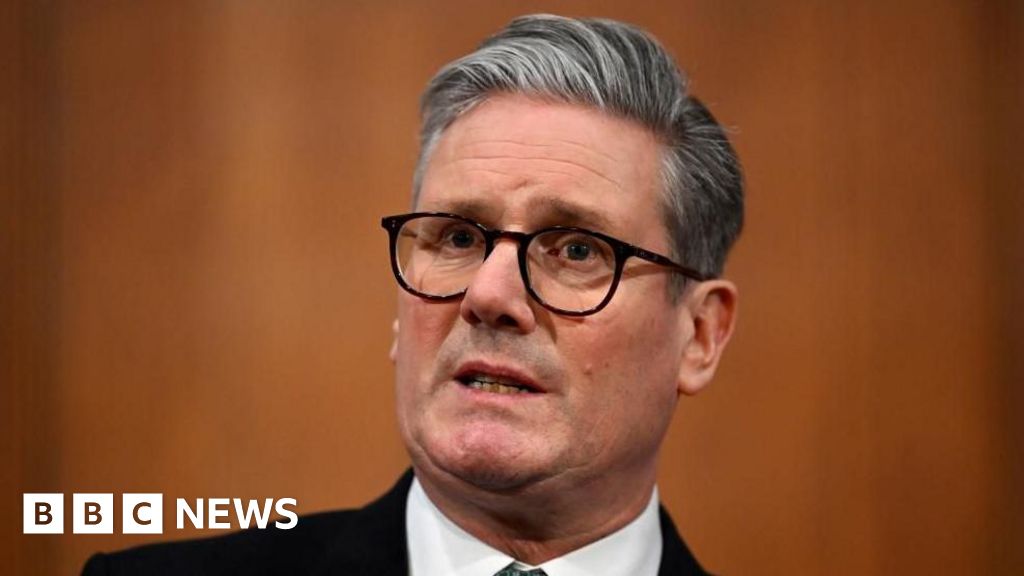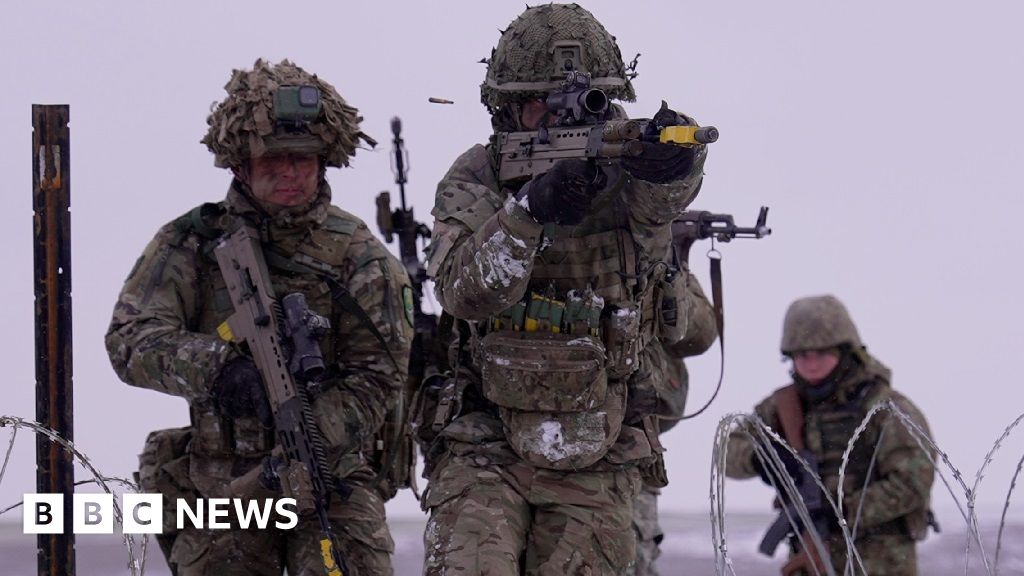
Defence Correspondent
Reporting from
Galați, Romania

BBC
The British Army has expressed its preparedness to deploy to Ukraine if the government requests such action.
This week, around 2,500 British troops from the Army’s First Division, known for its high readiness, have participated in a significant NATO exercise staged in Romania, merely 16 miles (25km) from the Ukrainian border.
Despite the prohibition of mobile phones during the exercise, many soldiers are cognizant of ongoing talks regarding the potential deployment of forces to Ukraine.
Brigadier Andy Watson, who is overseeing the UK’s contribution to the NATO drill, asserted that his brigade is “fully prepared” to deploy to Ukraine if given the order.
Earlier this week, Keir Starmer mentioned his willingness to send British troops to Ukraine to bolster its security, should a ceasefire be established.
However, he too lacks clarity on what specific actions they might be directed to undertake.
Regarding the number of troops that may be required, Brigadier Watson indicated that “the structure of the force would clearly depend on the preferences outlined by the Prime Minister and the Ministry of Defence.”
Yet he emphasized that “this is absolutely not something the UK could handle independently.” Brigadier Watson stated, “The Prime Minister has made it unequivocally clear that the UK would support these efforts, but not on our own.”
NATO’s Exercise Steadfast Dart, being the largest of the year, aims to exhibit the alliance’s capability to collectively respond to an ally’s defense when under threat. While showcasing NATO’s readiness, it also sheds light on its limitations.
The UK military has demonstrated its capacity to mobilize significant numbers of personnel and resources, including over 700 military vehicles, traveling 1,400 miles (2,253 km) across Europe on short notice as part of NATO’s new Allied Reaction Force.
Additionally, NATO is operating alongside personnel from more than eight European nations, totaling over 10,000 military members participating in this exercise.
Nonetheless, this figure represents only about 10% of the estimated troop strength believed necessary for any peacekeeping initiative in Ukraine, which could exceed 100,000 personnel.
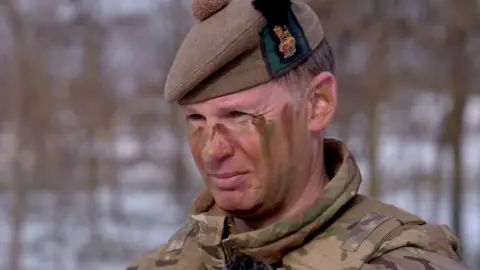
Some participating nations, such as Spain and Italy, have yet to meet NATO’s established defense spending benchmark of 2% of GDP, which has been in place for over a decade. Many countries, including the UK, have recently made reductions in their military forces.
In 2009, when British troops were deployed to Helmand, the Army boasted a strength of more than 100,000 regular soldiers.
Currently, the British Army is at its lowest strength since the Napoleonic Wars, with around 70,000 personnel. Even prior to these cuts, the Army was already stretched when sending a contingent of 9,000 troops.
Additionally, urgent operational requirements have necessitated increased defense spending for essential equipment, as well as rolling deployments of new troops every six months. A regular force of approximately 73,000 would now find it challenging to manage a similar scale operation.
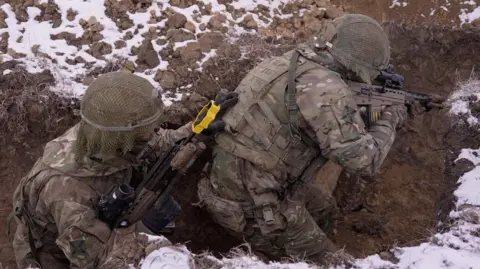
Steadfast Dart is designed to confirm that NATO’s European allies can effectively respond during a crisis.
Notably, US forces are not directly involved in this large NATO exercise. However, the United States continues to be NATO’s most significant military member, and its absence from any plan concerning Ukraine’s security raises concerns.
This is why Keir Starmer, alongside his Defence Secretary John Healey, is advocating for US involvement despite the previous administration’s firm stance against American troops on the ground.
Healey emphasized that while European nations must take the lead, “it is only the US that can provide the deterrent against Putin that is necessary to prevent further aggression.”
NATO’s intervention in Libya back in 2011 proved how difficult it can be for European countries to operate independently of their largest ally.
Although the US’s role was intended to be minimal during the air campaign, European nations highly relied on American support in logistics, air-to-air refueling, and intelligence operations.
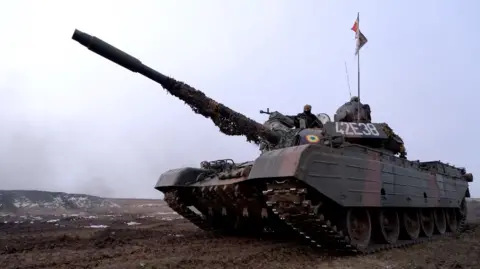
During Exercise Steadfast Dart, Colonel Gordon Muir, who commands the 4 Scots troops and previously served alongside the US in Afghanistan, remarked, “there’s a famous Highland saying – friends are valuable when it comes to battle.” He stressed that there are few situations where going it alone would be preferable.
Russia’s extensive invasion of Ukraine should have served as a crucial wake-up call for European nations. The majority of NATO members are now meeting the 2% GDP defense spending benchmark.
However, NATO Secretary General Mark Rutte has indicated that merely 2% is insufficient, advocating for an increase to more than 3%.
The Trump administration suggested that the figure should be closer to 5% of GDP. Meanwhile, the UK government has yet to establish a timeline for its new goal of 2.5%. Additionally, European production of defense materials has been sluggish.
Still, Exercise Steadfast Dart illustrates that some lessons from the conflict in Ukraine are being comprehended. There is a growing emphasis on training for trench and urban warfare, along with countering drone threats.
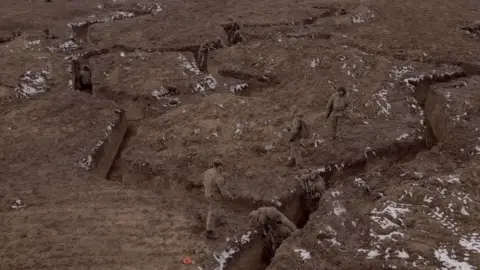
We observe British and Romanian soldiers conducting drills to clear snow-filled zigzag trench lines.
Numerous British troops engaged in this training have been instrumental in training their Ukrainian counterparts in the UK recently.
Corporal Richard Gillin of the 4 Scots stated, “We are definitely prepared for Ukraine.”
While they remain unaware of any potential deployment or roles, an operation in Ukraine could provide the UK Army with renewed purpose and assist in overcoming recruitment challenges.
Lance Corporal Lewis Antwis from the Royal Scots Dragoon Guards affirmed, “People have enlisted in the Army for purpose… so yes, I believe the soldiers are prepared.”





